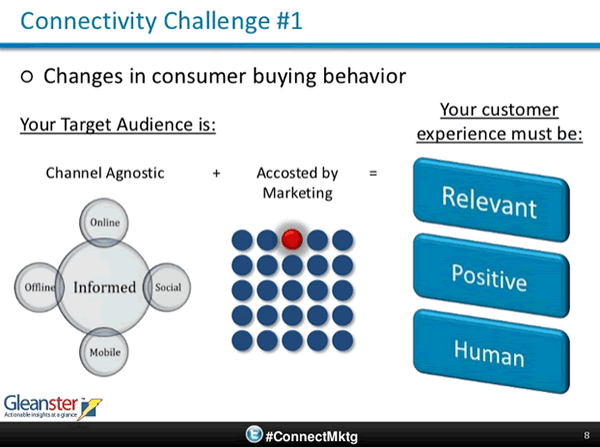
The link between CRM and digital interactions, touchpoints and campaigns, has never been clearer before than today. A customer-centric business has to interact with prospects in a multi-channel way with CRM processes as to gain insights, drive new actions and most of all putting the connected customer at the center of the business.
Furthermore, social CRM is involving people in earlier stages of the traditional funnel than before. Business can now engage with potential customers through social networks and multi-channel interactions, sooner in the buying journey or lead nurturing stage. The traditional funnel model is disrupted and conversions or touchpoints happen everywhere.
The CRM ecosystem of multiple touchpoints
While many businesses are trying to put the customer and his journey in the heart of the multi-channel marketing and CRM ecosystem, the borders between channels are blurring, fuelled by mobile devices and generations for whom channels are truly invisible as they grow up simply using them.
This goes far beyond now almost traditional topics such as converging and cross-fertilizing channels such as email and social. It also goes beyond offering multiple touch points depending on the customer journey stage.
In fact, people are becoming channel-agnostic and expect a consistent experience across every possible touchpoint and interaction moment. The consumer doesn’t think in terms of channels, marketers do.
Can we work in a customer-centric way in a multi-channel view? It certainly has many advantages to do so but on top of that, building a journey-centric approach is more than a matter of channels. In fact, it’s a matter of integration whereby internal processes, CRM and IT and marketing all are involved.
A multi-channel approach is not a channel-centric approach: the channel-agnostic buying journey
Marketing solutions, e-commerce applications and social interaction platforms are getting integrated into CRM processes, to understand the channel-agnostic customer and be where he is, or should we say “where he wants us to be”? A multi-channel approach is really more a multi-touchpoint approach in this reality whereby channels matter less than the actual customer journey.
A main challenge for businesses is to adopt that channel-agnostic view and to develop the proper approach whereby data from different – often very heterogeneous – sources and formats, should be integrated in a journey-centric perspective. That’s a huge challenge and exercise.
Transactional data, marketing metrics, social monitoring data and demographic data are all crucial, yet sometimes hard to integrate. However, it’s in those processes and exercises that a journey-centric support system is born and the data that really matter are translated in actionable metrics and KPIs.
A data-driven marketing strategy doesn’t mean using every little piece of information: it’s a selection process, steered by the business goals and obviously the customer journey. The same way, multi-channel doesn’t equal channel-centric. And the fact that the consumer is becoming channel-agnostic, does not mean mastering the channels is not important for marketers.

However, understanding how all these channels work together from a journey-centric perspective is much more important. Not for the sake of the channels but for the sake of the bottom-line and the consistent customer experience. That’s what a single customer view is really about: not about just having it but about making the customer experience a truly channel-agnostic one.
Top image purchased under license from Shutterstock
Also posted on the blog of our former customer Selligent.

